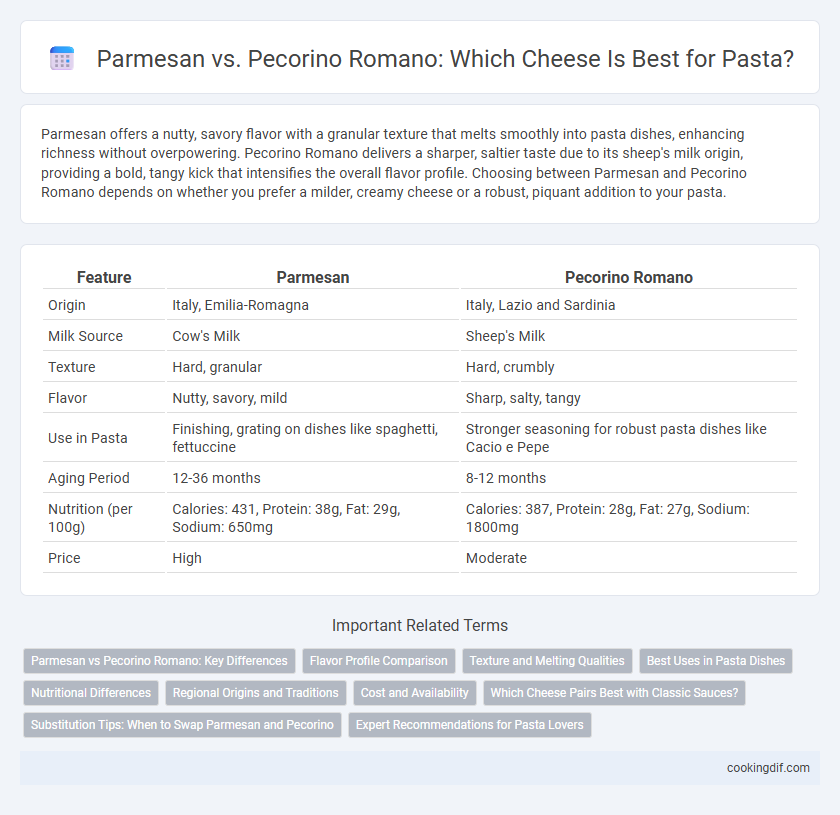Parmesan offers a nutty, savory flavor with a granular texture that melts smoothly into pasta dishes, enhancing richness without overpowering. Pecorino Romano delivers a sharper, saltier taste due to its sheep's milk origin, providing a bold, tangy kick that intensifies the overall flavor profile. Choosing between Parmesan and Pecorino Romano depends on whether you prefer a milder, creamy cheese or a robust, piquant addition to your pasta.
Table of Comparison
| Feature | Parmesan | Pecorino Romano |
|---|---|---|
| Origin | Italy, Emilia-Romagna | Italy, Lazio and Sardinia |
| Milk Source | Cow's Milk | Sheep's Milk |
| Texture | Hard, granular | Hard, crumbly |
| Flavor | Nutty, savory, mild | Sharp, salty, tangy |
| Use in Pasta | Finishing, grating on dishes like spaghetti, fettuccine | Stronger seasoning for robust pasta dishes like Cacio e Pepe |
| Aging Period | 12-36 months | 8-12 months |
| Nutrition (per 100g) | Calories: 431, Protein: 38g, Fat: 29g, Sodium: 650mg | Calories: 387, Protein: 28g, Fat: 27g, Sodium: 1800mg |
| Price | High | Moderate |
Parmesan vs Pecorino Romano: Key Differences
Parmesan, or Parmigiano-Reggiano, offers a nutty, savory flavor with a granular texture, aged for at least 12 months, ideal for melting and topping Italian pasta dishes. Pecorino Romano, made from sheep's milk, has a sharper, saltier taste and a harder, crumbly texture due to shorter aging, lending a robust, tangy flavor to pasta like Cacio e Pepe. While Parmesan enhances subtle richness, Pecorino Romano provides bold intensity, making them distinct choices depending on desired pasta flavor profiles.
Flavor Profile Comparison
Parmesan offers a nutty, savory flavor with a subtle fruitiness and a granular texture, enhancing pasta dishes with a rich umami depth. Pecorino Romano delivers a sharper, saltier taste with a robust, tangy bite and a crumbly consistency, providing a bold contrast that intensifies simple pasta recipes. Choosing between Parmesan and Pecorino Romano depends on the desired flavor intensity and the specific pasta sauce, balancing the creamy warmth of Parmesan against the piquant edge of Pecorino Romano.
Texture and Melting Qualities
Parmesan cheese, known for its granular texture and rich umami flavor, melts smoothly into pasta sauces, creating a creamy consistency without overpowering the dish. Pecorino Romano features a coarser, saltier texture and maintains a firmer bite even when heated, offering a sharper contrast in both flavor and mouthfeel. The melting qualities of Parmesan lend themselves well to delicate, silky sauces, while Pecorino Romano's texture enhances robust, hearty pasta recipes.
Best Uses in Pasta Dishes
Parmesan, with its nutty and savory flavor, is ideal for enhancing creamy pasta sauces like Alfredo or carbonara, where it melts smoothly and adds depth. Pecorino Romano offers a sharper, saltier taste and firmer texture that complements robust dishes such as Cacio e Pepe or amatriciana, where its boldness stands out against spicy or peppery notes. Using Parmesan for subtle, creamy recipes and Pecorino Romano for intensely flavored, rustic pasta dishes maximizes the unique qualities of each cheese.
Nutritional Differences
Parmesan cheese is lower in sodium and fat compared to Pecorino Romano, making it a lighter option for pasta dishes. Pecorino Romano contains higher protein content and more calcium, which supports bone health but also has a significantly saltier taste due to its higher sodium levels. Both cheeses are rich in vitamins A and B12, but Parmesan's aged fermentation process enhances its digestibility and contributes beneficial probiotics.
Regional Origins and Traditions
Parmesan, originating from the Emilia-Romagna and Lombardy regions of Italy, is traditionally made from cow's milk and aged for at least 12 months, imparting a nutty and savory flavor essential in Northern Italian pasta dishes. Pecorino Romano, hailing from Lazio, Sardinia, and Tuscany, is crafted from sheep's milk, known for its sharp, salty taste that complements central and southern Italian recipes like spaghetti alla carbonara. These regional cheeses reflect local agricultural practices and culinary traditions, shaping distinct flavor profiles that highlight the heritage of their respective pasta dishes.
Cost and Availability
Parmesan cheese generally costs more than Pecorino Romano due to its longer aging process and widespread premium branding. Parmesan is widely available in most grocery stores and supermarkets globally, making it accessible for everyday cooking. Pecorino Romano, often cheaper and more accessible in Mediterranean or specialty cheese shops, offers a saltier and sharper flavor, providing a cost-effective alternative for pasta dishes.
Which Cheese Pairs Best with Classic Sauces?
Parmesan cheese pairs best with classic tomato-based sauces like marinara and Bolognese due to its nutty, savory flavor that enhances the sauce's acidity. Pecorino Romano complements creamier sauces such as Alfredo or carbonara, offering a sharp, salty tang that balances rich, buttery textures. Choosing between Parmesan and Pecorino depends on the sauce's flavor profile and the desired intensity of cheese.
Substitution Tips: When to Swap Parmesan and Pecorino
Parmesan and Pecorino Romano can be swapped in pasta recipes depending on flavor intensity and saltiness preferences; Parmesan offers a nutty, mild taste ideal for creamy sauces, while Pecorino Romano provides a sharper, saltier profile that enhances robust, tomato-based dishes. Substitute Pecorino Romano for Parmesan to add a distinctive tang and saltiness, reducing added salt in recipes accordingly. Use Parmesan as a more subtle alternative when a less pronounced cheese flavor is desired or when balancing delicate ingredients.
Expert Recommendations for Pasta Lovers
Expert recommendations for pasta lovers highlight Parmesan and Pecorino Romano as essential cheeses, each offering distinct flavors that enhance different pasta dishes. Parmesan, known for its nutty and savory profile, pairs exceptionally well with creamy sauces and delicate pasta like fettuccine Alfredo. Pecorino Romano's sharp, salty taste complements robust, tomato-based sauces and works best in classic Roman dishes such as Cacio e Pepe.
Parmesan vs Pecorino Romano for cheese Infographic

 cookingdif.com
cookingdif.com